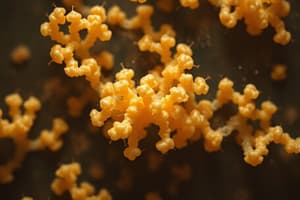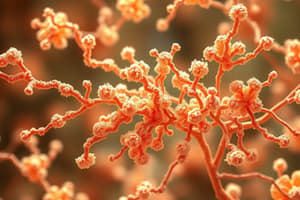Podcast
Questions and Answers
Which characteristic is true for Corynebacterium diphtheriae?
Which characteristic is true for Corynebacterium diphtheriae?
- It is arranged in chains resembling Chinese letters. (correct)
- It has a thick peptidoglycan layer. (correct)
- It forms endospores.
- It does not transmit via airborne droplets.
What is a common complication associated with diphtheria?
What is a common complication associated with diphtheria?
- Toxic myocarditis (correct)
- Chronic cough
- Severe dehydration
- Skin infections
Which type of agar is best for observing the morphology of Corynebacterium diphtheriae?
Which type of agar is best for observing the morphology of Corynebacterium diphtheriae?
- Nutrient agar
- Loeffler's serum (correct)
- MacConkey agar
- Blood tellurite agar
What is the primary mode of transmission for diphtheria?
What is the primary mode of transmission for diphtheria?
Which feature is NOT associated with Gram-positive bacilli?
Which feature is NOT associated with Gram-positive bacilli?
What microscopic appearance is characteristic of Corynebacterium diphtheriae when using a Gram stain?
What microscopic appearance is characteristic of Corynebacterium diphtheriae when using a Gram stain?
Which media is considered best for observing better morphology of Corynebacterium diphtheriae?
Which media is considered best for observing better morphology of Corynebacterium diphtheriae?
What is true regarding Listeria monocytogenes compared to Corynebacterium diphtheriae?
What is true regarding Listeria monocytogenes compared to Corynebacterium diphtheriae?
Which test is the most common assay for determining the toxigenicity of Corynebacterium diphtheriae?
Which test is the most common assay for determining the toxigenicity of Corynebacterium diphtheriae?
What is a primary disease caused by Listeria monocytogenes during the peripartum period?
What is a primary disease caused by Listeria monocytogenes during the peripartum period?
Flashcards
Gram-positive bacilli
Gram-positive bacilli
Bacteria with a thick peptidoglycan layer that retains crystal violet stain during Gram staining.
Peptidoglycan layer
Peptidoglycan layer
A thick layer surrounding the cell wall of Gram-positive bacteria, responsible for retaining the crystal violet stain.
Capsule formation
Capsule formation
Some Gram-positive bacteria produce a capsule, a protective layer that helps them evade the host's immune system.
Spore formation
Spore formation
Signup and view all the flashcards
Bacillus anthracis
Bacillus anthracis
Signup and view all the flashcards
Corynebacterium diphtheriae
Corynebacterium diphtheriae
Signup and view all the flashcards
Metachromatic granules
Metachromatic granules
Signup and view all the flashcards
Diphtheria Exotoxin
Diphtheria Exotoxin
Signup and view all the flashcards
Diphtheria
Diphtheria
Signup and view all the flashcards
Pseudomembrane
Pseudomembrane
Signup and view all the flashcards
Corynebacterium diphtheriae
Corynebacterium diphtheriae
Signup and view all the flashcards
Elek's test
Elek's test
Signup and view all the flashcards
Diphtheroids
Diphtheroids
Signup and view all the flashcards
Listeria monocytogenes
Listeria monocytogenes
Signup and view all the flashcards
Gram-positive bacilli
Gram-positive bacilli
Signup and view all the flashcards
Metachromatic granules
Metachromatic granules
Signup and view all the flashcards
Motile
Motile
Signup and view all the flashcards
Study Notes
Gram-Positive Bacilli: Anthrax and Corynebacterium Diphtheriae
- Gram-positive bacteria possess a thick peptidoglycan layer, retaining crystal violet stain during Gram staining.
- Some species, like Bacillus anthracis, have a capsule, a protective layer that helps them evade the host's immune system.
- Certain gram-positive bacteria, such as Bacillus species, can form endospores, resistant structures that survive harsh environmental conditions.
- Corynebacterium diphtheriae has characteristic metachromatic granules, which appear as dark-staining bodies within the cells.
Gram-positive Bacilli: Types
- Non-spore forming:
- Corynebacterium
- Listeria
- Spore forming:
- Bacillus
- Clostridium
Corynebacterium
- Some Corynebacterium species are part of normal skin and mucosal flora.
- Corynebacterium diphtheriae is a medically important species.
Morphology of Gram-Positive Bacilli
- Gram-positive bacilli are club-shaped.
- They are arranged in acute angles or parallel to each other (Chinese letters).
- They exhibit metachromatic granules.
- They are non-spore forming.
Culture Characteristics
- C. diphtheriae grows aerobically.
- Grows well on blood agar.
- Loeffler's serum is best for morphology, showing grey-to-black colonies.
- Blood tellurite agar is selective and differential, excluding S. pyogenes.
Virulence Factors
- Diphtheria Exotoxin: A significant virulence factor.
Diphtheria
- Contagious upper respiratory infection transmitted by droplets.
- Characterised by local pseudomembrane formation and toxemia.
- Complications include airway obstruction, toxic myocarditis/heart failure, and nerve paralysis.
Diagnosis
- Specimen: A throat swab from the pseudomembrane.
- Direct Detection (Microscopy) Detects gram-positive bacilli and Chinese letter arrangement, plus metachromatic granules using methylene blue stain.
- Cultivation: Using Loeffler's serum or blood tellurite agar for culture.
- Identification: Gram-stained smear and observation of metachromatic granules.
Toxigenicity Tests
- Elek's test: detects toxin production.
- PCR: For detection of toxin genes.
- ELISA: For detection of toxin.
Diphtheroids
- Corynebacteria resembling C. diphtheriae morphologically.
- Mostly commensals of the throat, skin, and respiratory tract.
- Non-spore forming, non-motile, and gram-positive bacilli with characteristic arrangements in angles or palisades.
- Can cause diseases, primarily urinary tract infection, bacteremia.
Listeria monocytogenes
-
Gram-positive rods.
-
Exhibit tumbling motility at 25°C ("umbrella" type motility).
-
Listeria resembles Corynebacteria in morphology.
-
Listeria is cold-tolerant, growing in refrigerated food, and drinks.
-
Causes neonatal meningitis and other forms of listeriosis, as well as adult listeriosis.
-
Transmission through contact, unpasteurized dairy and undercooked meat, usually associated with pregnant women, babies and adults with compromised immune systems.
-
Diagnosis involves blood culture and cerebrospinal fluid culture, demonstration of gram-positive bacilli.
-
Listeria colonies often form a narrow zone of hemolysis similar to Group B Streptococcus on blood agar.
Anthrax
- Caused by Bacillus anthracis.
- A zoonotic disease, primarily in herbivores, transmitted to humans through contact, contaminated products, or soil.
Bacillus anthracis
- Aerobic, Gram-positive, rod-shaped bacterium forming spores, an important zoonotic disease.
- Can lead to Cutaneous, Inhalational, and Gastrointestinal anthrax.
- Diagnosed by clinical presentation, microscopic examination (large, square-ended, spore-forming bacilli), culture on blood agar or suitable media, and serological tests.
Anthrax: Clinical Manifestations
- Cutaneous anthrax is characterized by cutaneous skin lesions, progressing to black eschars.
- Inhalation anthrax presents initially as flu-like symptoms, with respiratory distress developing later.
- Gastrointestinal anthrax involves severe abdominal pain, nausea, and vomiting after ingesting contaminated meat.
- Injection anthrax is associated with drug injection, symptoms similar to cutaneous anthrax.
Anthrax: Diagnosis
- Diagnosis often depends on clinical presentation and microscopic examination of large, square-ended, spore-forming bacilli.
- Gram-stained smears and cultures on blood agar or other suitable media with the observation of non-haemolytic reaction with Medusa head colonies provide definitive identification.
- Inverted fire tree appearance on gelatin media also supports diagnosis.
Pathogenic and Saprophytic Bacillus species
- Bacillus anthracis: Pathogenic, causes anthrax.
- Bacillus cereus: Saprophytic, causes food poisoning.
Potential Bioterrorism Concerns
- Anthrax spores are highly stable and can survive for extended periods and be transmitted by aerosols.
- C. diphtheriae is a highly contagious bacteria, producing a toxin causing severe illness and death.
Review Questions
- Culture of C. diphtheriae: Loffler's serum provides best cultivation, observing morphology of grey to black colonies.
- Blood tellurite agar: Selective and differential medium for identification of Corynebacteria spp
- Toxigenicity test: Elek's test identifies toxigenicity for C. diphtheriae.
- Morphology of C. diphtheriae: Gram-positive bacilli, arranged in club-shaped, Chinese letter formation.
- Etiological diagnosis for neonatal meningitis: Listeria monocytogenes, with eating unpasteurized cheese as the high-probability suspect .
Studying That Suits You
Use AI to generate personalized quizzes and flashcards to suit your learning preferences.
Related Documents
Description
Explore the fascinating world of gram-positive bacilli, focusing on Bacillus anthracis and Corynebacterium diphtheriae. Learn about their unique features, including their structural adaptations like spore formation and metabolic granules. This quiz covers their classification, morphology, and significance in health and disease.




